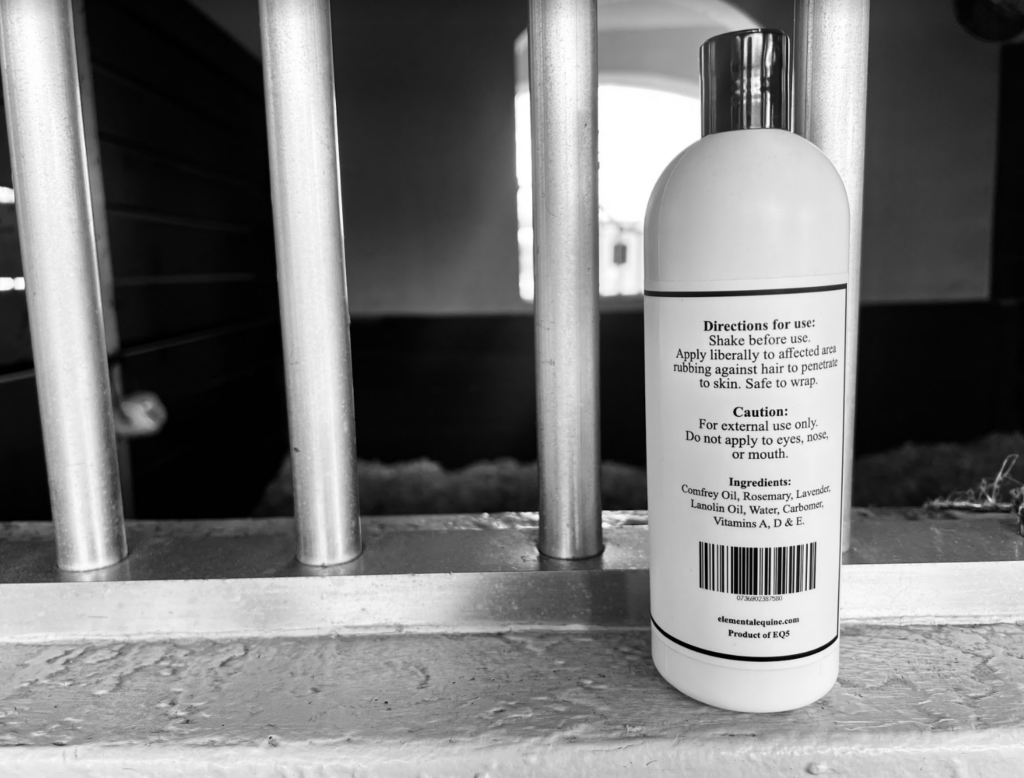Did you know that some “natural” supplements or herbals that we humans regularly take can contain products that are prohibited (think ginger root, chamomile and valerian, for example)? And did you know that allowing your horse to ingest a Coke or other product with caffeine -or a muffin or bagel containing poppy seeds- could result in a positive drug test?
Yup, it’s true. You have to be so careful nowadays with what you feed and put on your horse, but also with what he can inhale or lick.
In September 2022, the magazine of the United States Hunter Jumper Association (USHJA), In Stride, published a helpful article about the ingredients of all kinds of food and things that can enter the horse’s system. Tricia Booker, the editor of In Stride, was so kind to let us share this article on www.horsegrooms.com so more people can be made aware of the importance of reading product labels.
This article focuses on the rules of competing nationally in the U.S.A. under the regulations of the United States Equestrian Federation (USEF), so the details can differ per country but the overall message stays the same: read product labels and make sure the ingredients are allowed!

Do You Read Product Labels?
If you’re competing and giving your horse medications, supplements, topical applications or even treats, the answer should be a resounding ‘Yes!’
By Nancy Jaffer
Originally published in USHJA’s In Stride Magazine in September 2022
Those who show at United States Equestrian Federation-licensed competitions most likely know the basics when it comes to prohibited drugs and medications. Delving deeper, however, you might not realize that some “natural” supplements or herbals that we humans regularly take can contain products that are also prohibited (think ginger root, chamomile and valerian, for example). And did you know allowing your horse to ingest a Coke or other product with caffeine—or a muffin or bagel containing poppy seeds—could result in a positive drug test?
A label-reading routine
Therefore, it’s imperative as a horse owner/rider/trainer that you become well-versed in the contents of the “USEF Guidelines and Rules for Drugs and Medications” pamphlet and develop a label-reading routine to ensure compliance with USEF Drugs & Medication rules.
Horses and ponies competing at USEF-licensed competitions are subject to drug testing. However, you might not be aware that any horse or pony on the show grounds, whether in competition or not, is subject to testing—even your 3-year-old who is just “hanging out” to experience his first horse show.
Know the Rules
There’s no substitute for knowing the USEF’s “D&M” rules or learning how to obtain more information about them, if needed. You should know the rules and understand what medications/ supplements your horse is receiving, and why.
“You’re susceptible to the same rules and regulations as everyone else,” said Nanci Snyder, since 2012 the stable management clinician for many of the USHJA’s Emerging Athletes Program Regional Training Sessions. She noted that although the trainer is primarily responsible for a positive drug test, the owner may lose prize money, points and face a possible fine even if they aren’t involved in the day-to-day care of the horse.
Be sure to bookmark this link for a handy reference: usef.org/compete/resources-forms/rules-regulations/drugs-medications.
Routine Isn’t Always Routine
Those who are starting to compete in USEF-licensed shows and are not working with a trainer or experienced stable manager must pay special attention to D&M regulations, understand the differences between permitted, prohibited and restricted substances and know when an official USEF Medication Report Form (MRF) needs to be filed.
These resources are available in the USEF Rulebook and online (usef.org). Competitors should always consider the rules, even when dealing with the most basic horse care routines.
Sedative or Tranquilizer
Using a short-acting sedative or tranquilizer for shipping, clipping, shoeing, dental work or other management duties does not constitute a therapeutic use, which means owners/trainers should carefully monitor the withdrawal times before competing to remain in compliance.
Antibiotic Ointment
Snyder noted that using the correct antibiotic ointment is just one example of why you should study a product’s ingredients before you buy it for your horse. The ordinary triple antibiotic ointment sold at your local pharmacy or grocery may be on the shelf next to a similar-looking tube that includes lidocaine, which requires an MRF if it’s used on a horse competing at a USEF-licensed show.
The same caution extends to everything from Epsom salts to shampoo.
Changes
While it’s important to check the USEF’s list of substances prohibited in competition, exhibitors should know that some of those forbidden items may not be obvious, and they can change from time to time.
Snyder cited the case of lavender, which previously was on the prohibited list but is now not listed. When Snyder emailed the USEF to check on that change, she was told that “lavender is permitted topically and when used in aromatherapy. It is prohibited when ingested.”
Only a Guideline
She was also reminded that the list is only a guideline of substances and ingredients, and USEF staff members encourage everyone to reach out to them with questions: (800) 633-2472 and or medequestrian@aol.com.
It’s important to note that, although the use of some products may not have resulted in positive drug tests in the past, that could change as the laboratory incorporates new methods into its battery of screening tests, so it’s necessary to keep up to date.
Natural Isn’t Always Legal
“Just because they’re ‘natural’ doesn’t mean they’re allowed,” said Snyder, who runs a Jumper stable and has worked for such top competitors as Michael Matz and Peter Wylde. “It’s vital to be aware—not just about medications, but also everyday products bought online and used at the barn.”
She emphasized how important it is to know what’s in the substances applied topically or ingested by show horses.
Treats
That awareness also applies to human treats that you might want to share with your horse, not realizing they could contain something like caffeine, which is a forbidden item for showing. Even products that are made for horses may violate the USEF rules and can include an ingredient that would result in a positive test.
Nibling on Bandages
One common example is a product sprayed on bandages or blankets to prevent a horse from chewing on them. If it contains capsaicin, a peppery substance, a positive test can result in a violation if the horse ingests it while nibbling at its bandages. Capsaicin was the culprit in the disqualification of four Jumper riders at the 2008 Olympic Games in Hong Kong. (Capsaicin is a lotion or paste derived from the chili pepper plant that, when applied, can have hypersensitizing effects or pain relief, that, in both cases, can improve the performance of the horse.)
Medication Report Form (MRF)
When veterinarians prescribe or dispense medication, there’s a temptation to rely on their expertise in terms of whether it is “legal” or not under USEF standards. A lot of treatments that go on MRFs don’t take place on the showgrounds, but rather, at home before attending the show by a barn’s regular veterinarian, who may not be as familiar with the rules as a show veterinarian.
“Any top show-level veterinarian should know the rules and should be able to give you answers about what’s legal with timing and amounts,” said Snyder. “Ultimately, though, we are all a team, and anyone can call/email the USEF for the correct information to double check.”
FEI
Also, be aware that the Fédération Equestre Internationale (FEI) has some different drug rules than the USEF, so for those who are moving up to such classes, another level of learning is required. You can check for their prohibited substances list here: inside.fei.org/fei/cleansport.
Become a D&M Expert
The USEF Drugs and Medications rules exist to protect the welfare of the horse as well as to ensure a fair and level playing field for competitors. The USEF website is a great resource for exhibitors to learn more. Its offerings include the USEF Rulebook, the “2022 USEF Guidelines & Rules for Drugs and Medications” pamphlet (handy to keep in your tack trunk), and several online videos and PDFs.
Prohibited or Forbidden?
In the video link below, Stephen Schumacher, DVM, chief administrator of the USEF’s Equine Drugs and Medications Program (equine clean sport), discusses the differences between permitted, forbidden (now referred to as prohibited) and restricted medications; use of common medications and supplements in treating horses; understanding therapeutic versus non-therapeutic situations; and the importance of working carefully and closely with your veterinarian to understand and remain in compliance with USEF rules: https://www.usef.org/learning-center/videos/usef-drug-rules-explained
Key bullet points in the video include:
• Classifications of Medications
• NSAIDs
• Joint Supplements
• Corticosteroids
• General Rule 411
• Short-Acting Tranquilizers and Sedatives
For more information on banned and controlled substances, withdrawal and detection times, and more, check out Your Guide to Drug and Substance Use for FEI Competing Horses.


